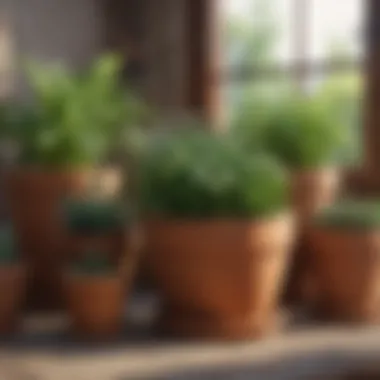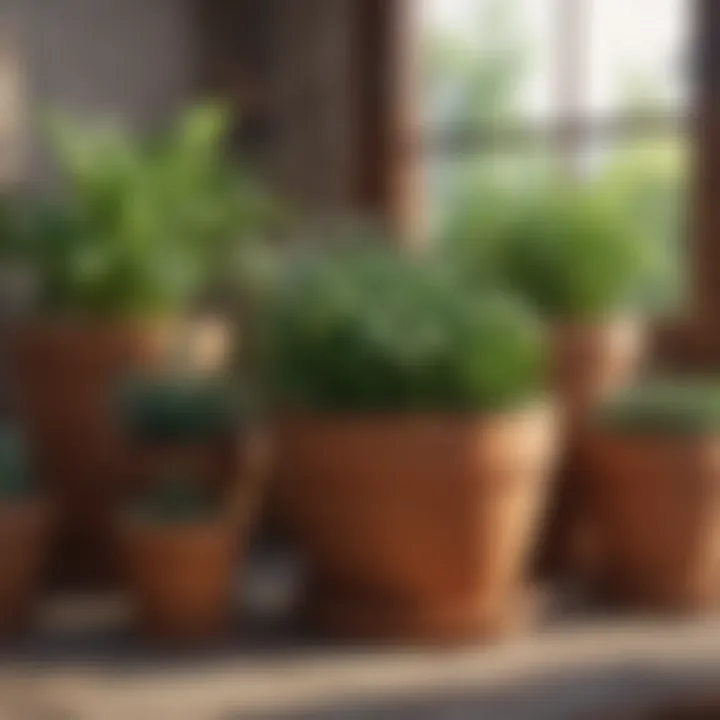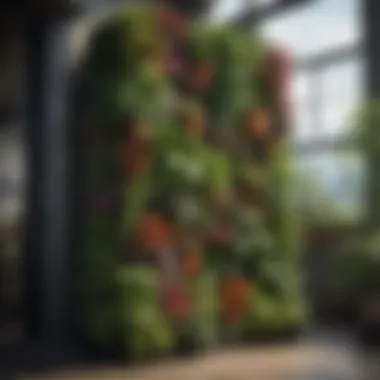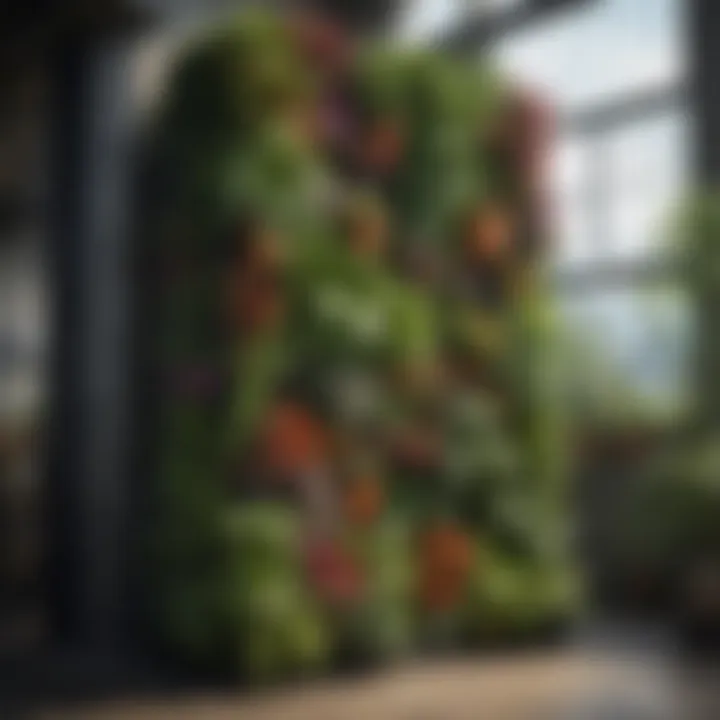Mastering Container Gardening: Ideal Crops & Tips


Overview of the Topic
Definition and Importance
Container gardening refers to the practice of growing plants in containers instead of traditional garden beds. This method is especially important in urban areas where space is limited. It allows individuals to cultivate a diverse range of plants, even in small spaces like balconies or patios. The choice of container gardening has grown in popularity due to its accessibility, environmental benefits, and aesthetic appeal. A well-tended container garden can not only enhance the beauty of a space but also provide fresh produce or flowers.
Current Trends
Today, there is a visible shift towards sustainable gardening practices. More people are opting for organic methods and native plants that require less water and care. Vertical gardening is another trend that complements container gardening, maximizing space usage. Many urban gardeners are turning to recycled materials for their containers, promoting an eco-friendly approach. This reflects a broader awareness of environmental issues.
Key Techniques and Practices
Step-by-Step Guide
- Select Your Container: Choose based on size, material, and drainage capacity. Common materials include terra cotta, plastic, or metal. It's crucial that each container has drainage holes to prevent water from accumulating.
- Choose the Right Soil: Use potting mix specifically designed for container gardening. This usually has a good balance of drainage, moisture retention, and nutrients. Avoid using garden soil, as it can become compacted.
- Pick the Right Plants: Select plants suitable for your environment and objectives. Consider factors like sunlight, moisture levels, and your gardening goals—whether for aesthetics, utility, or sustainability.
- Watering Needs: Containers may dry out faster than garden beds, requiring more frequent watering. Check moisture levels regularly and water appropriately.
- Fertilization: Use a controlled-release fertilizer to provide nutrients over time. Adjust according to plant types and their growth stages.
Tools and Equipment Needed
- Containers: Based on plant choice
- Potting Soil: Quality mix is essential
- Watering Can: For efficient watering
- Trowel: Useful for planting and soil maintenance
- Fertilizers: Appropriate for container plants
Challenges and Solutions
Common Obstacles
Growing plants in containers can present several challenges. Limited soil volume can restrict nutrient availability and moisture retention. Additionally, plants may suffer from temperature fluctuations more than those planted in the ground.
Innovative Solutions
- Self-Watering Containers: These can help manage moisture levels effectively.
- Succession Planting: This technique involves planting new crops as others are harvested to maximize yield over time.
- Companion Planting: Planting compatible species together can enhance growth and deter pests.
Container gardening not only optimizes space but also encourages biodiversity by allowing for the growth of various plant species in close proximity.
Container gardening is an effective means to cultivate a rich array of plants while adapting to various environmental conditions. It is equally beneficial for those seeking to enhance their living space and those looking for sustainable gardening practices.
Prelims to Container Gardening
Container gardening represents a unique opportunity for individuals to engage with the soil and plant life, regardless of their spatial constraints. As urban areas grow denser, the art of growing plants in containers has gained significance. The flexibility offered by container gardening allows for a myriad of applications—from beautifying balconies to producing fresh vegetables in small apartments. This approach not only enhances the aesthetics of a space but brings practical benefits that can lead to a more sustainable lifestyle.
Definition and Benefits
Container gardening involves cultivating plants in pots or other containers instead of traditional in-ground gardening. This practice is accessible to anyone, regardless of gardening skill level or available space. The containers can vary in size, shape, and material, allowing for a diverse array of gardening possibilities.
The benefits of container gardening include:
- Space Utilization: It optimizes small spaces, making it ideal for urban living.
- Mobility: Containers can be moved to capture optimal sunlight or protection from weather extremes, ensuring that plants receive ideal conditions for growth.
- Soil Control: Gardeners can customize the soil in their containers to meet the specific needs of the plant species they are growing.
- Pest Management: Container gardening can reduce soil-borne pests and diseases, offering a cleaner environment for plant growth.
"Container gardening allows for creativity and practicality, presenting an ingenious alternative to conventional gardening approaches."
Furthermore, container gardening promotes sustainability. With careful plant selection and management, individuals can yield significant harvests while minimizing their environmental footprint. This practice not only enhances the quality of life but also contributes positively to the ecosystem.
Optimizing container gardening is essential for those looking to maximize growth potential in limited environments. By understanding what to grow, individuals can make informed decisions that align with their aesthetic preferences, nutritional needs, and environmental considerations.
Assessing Your Space and Environment
Understanding your space and environment is crucial in container gardening. Each area presents unique challenges and opportunities. Success in container gardening often depends on how well you assess these factors. This assessment should encompass various elements, including sunlight exposure, temperature fluctuations, and microclimates at your location. By recognizing these details, you can make informed decisions about what to plant, ultimately enhancing growth potential and yield.
Sunlight Requirements
Sunlight is a primary factor for plant growth. Different plants have varying light demands. Some require full sun, while others flourish in partial shade. Before selecting plants, evaluate how much sunlight your space receives throughout the day.
- Full Sun: At least six hours of direct sunlight daily. Ideal for vegetables like tomatoes and peppers, as well as many flowers.
- Partial Shade: 3 to 6 hours of sunlight. Suitable for leafy greens like spinach and herbs like basil.
- Full Shade: Less than 3 hours of sunlight. Consider shade-tolerant options like ferns or certain types of lettuce.
Measuring sunlight can be as simple as observing the area over a week. Take notes about the time of day sun is present. This knowledge helps ensure that you are selecting the appropriate plants for your conditions.
Temperature Considerations
Temperature significantly influences what can be grown in containers. Most plants thrive within specific temperature ranges. Understanding the climate of your area allows you to choose plants that will not only survive but also flourish.
- Frost Dates: Identifying first and last frost dates in your region is imperative. This helps in planning planting time for warm-season crops.
- Heat Tolerance: Choosing varieties that can withstand higher temperatures is advisable in hotter climates. For instance, peppers and eggplants perform well in warm conditions.
- Cold Resistance: In cooler areas, opt for hardy plants like kale and certain root vegetables.
Monitoring temperatures at different times through the growing season can also inform your choices in subsequent years. Adjusting your planting schedule based on temperature trends can enhance success rates.
Microclimates in Your Location
Microclimates are small areas within your broader environment that have different climatic conditions. Factors such as buildings, trees, and other structures can alter light and temperature significantly.
- Sun Exposure: Areas near walls or buildings may receive more heat and can be ideal for warmth-loving plants.
- Wind Protection: Sheltered spots can protect plants from harsh wind conditions, which may be beneficial for fragile varieties.
- Soil Conditions: Some microclimates may retain moisture better or have different soil types. Recognizing these distinctions will help in selecting the right plants.
By understanding these subtleties, you'll be better equipped to maximize the potential of your container garden. Each consideration places you one step closer to creating an optimal growing environment.
Selecting Containers for Gardening


Selecting the right containers for gardening plays a crucial role in optimizing plant growth. The choice of container directly influences factors such as drainage, root development, and the overall health of the plants. Different plants have distinct needs, and the container must meet those requirements to ensure successful cultivation.
By understanding various types of containers, the materials used, and the essential size specifications, gardeners can enhance their gardening experience. Choosing thoughtfully will set the stage for robust plants and an aesthetically pleasing garden.
Types of Containers
Containers come in various shapes and sizes, and each type offers unique advantages. Here are some common options:
- Plastic containers: Lightweight and easy to handle. They often come in various colors and designs. However, they may retain heat more than other materials.
- Ceramic pots: These pots often feature beautiful glazes, making them visually appealing. Although they are heavier and more fragile, they offer good insulation.
- Metal containers: Usually durable, metal containers like galvanized steel or copper can make striking garden features. Keep in mind that they can heat up quickly under the sun.
- Fabric grow bags: An innovative option, they provide excellent drainage and air circulation. They help prevent root circling, which is a common issue with plastic pots.
In selecting containers, consider the specific needs of the plants you wish to grow. This choice can determine how well your plants thrive throughout the growing season.
Material Considerations
The material of the container affects not only the aesthetics but also the plant’s health. Each material presents distinct pros and cons. For instance:
- Plastic containers: They are economical and lightweight but may limit air circulation and heat dissipation.
- Terracotta: Natural and porous, these pots allow moisture to evaporate, reducing the risk of root rot. However, they can break easily and may not suit every setting.
- Wooden containers: They blend well with nature but require treatment to prevent decay. The size and type of wood can impact the longevity of the container.
- Concrete: While heavy and durable, concrete requires decent insulation to prevent overheating roots during summer.
Choose a container that aligns with your gardening goals while considering durability and insulation properties.
Size and Drainage Needs
The size of the container is critical in promoting healthy root development. A larger container allows for more soil and better water retention. Conversely, overly small containers can restrict root growth and water access.
Implementing proper drainage is essential. Without adequate drainage holes, excess water can pool at the bottom, leading to root rot. Here are some guidelines for optimizing size and drainage:
- Ensure each container has holes at the bottom for water to escape.
- When selecting size, consider mature plant dimensions to avoid transplanting too frequently.
- Use a potting mix designed for container plants, as it balances moisture retention and drainage. This mix often includes ingredients like perlite or bark.
Tip: Monitor plants regularly to ensure they receive the correct amount of water. Container gardening demands attention to plant needs, particularly regarding their water levels.
By understanding these elements, gardeners can make informed decisions that support healthier plant growth. Selecting the right containers is an investment in the success of any container gardening project.
Essential Soil Mixes for Containers
Optimizing plant health and growth in container gardening largely hinges on the soil mix utilized. The right soil comprises essential nutrients, improves drainage, and promotes aeration. A quality soil mix creates a favorable environment for root development, ultimately impacting the yield and vitality of the plants. Without adequate attention to soil mixes, even the best plant varieties may struggle to thrive.
Ingredients for Optimal Growth
When creating an optimal soil mix for containers, certain ingredients rise to prominence. Generally, a well-rounded mix will include:
- Peat Moss: This ingredient holds moisture effectively and offers good aeration, making it fundamental for container gardens. It breaks down slowly, providing a long-lasting structure that supports plant roots.
- Compost: Rich in nutrients, compost enhances soil fertility. It contains essential microbial life that contributes to the decomposition process, improving soil structure over time.
- Perlite or Vermiculite: Adding these components improves drainage and aeration. Perlite is volcanic glass that prevents soil compaction, while vermiculite aids in moisture retention.
- Coconut Coir: This is an excellent organic alternative, facilitating aeration and moisture retention, while being sustainable. It has a low electrical conductivity, which is beneficial for new gardeners who may over-fertilize.
- Worm Castings: Packed with nutrients, worm castings serve as a natural fertilizer, enhancing microbial activity and improving soil richness.
An exemplary mixture might consist of two parts peat moss, one part compost, one part perlite, and a small quantity of worm castings for added nutrients. Adjusting these ratios may be necessary depending on the types of plants chosen.
pH Level Considerations
pH levels determine the soil's acidity or alkalinity and influence a plant's ability to absorb nutrients. Most container plants prefer a pH range of 6.0 to 7.0. Monitoring and adjusting pH can be crucial for success.
- Testing pH: Use pH test kits or meters to assess soil conditions accurately. Testing can be done through home kits available at garden centers or online.
- Adjusting pH: If the soil mixture is too acidic, incorporate lime to raise pH. Conversely, adding sulfur can lower pH. This process should be gradual, as it takes time for soil chemistry to normalize.
- Plant Selection: Some plants are more tolerant and adaptable to varying pH levels—this can dictate choices in plant selection. For example, blueberries thrive in more acidic soil, while many vegetables prefer neutral to slightly acidic conditions.
In essence, fine-tuning soil mixes and pH levels directly correlate to plant health and productivity in container gardening. The practices laid out aim to provide a robust foundation for successful horticulture in confined spaces.
Plant Selection Strategies
Selecting the right plants for container gardening is fundamental in optimizing the yield and aesthetics of your garden. Each type of plant has its own specific requirements in terms of light, water, and space. Understanding these requirements can lead to a more successful gardening experience, particularly in limited spaces. This section will delve into various categories of plants that are especially well-suited for containers.
Herbs for Container Gardens
Herbs are ideal candidates for container gardens due to their versatility and compact size. They thrive in smaller pots and can be strategically placed on patios, windowsills, or balcony railings. Herbs like basil, parsley, and thyme not only add flavor to dishes but also provide fragrance and greenery to your space.
When choosing herbs, consider the following factors:
- Light Requirement: Most herbs prefer full sun, at least six hours a day.
- Water Needs: While some herbs like mint require more moisture, others such as oregano can tolerate dry conditions.
- Growth Habit: Some herbs, such as dill or basil, might need regular pruning to maintain size and promote bushy growth.
This allows gardeners to maximize their limited space while providing fresh ingredients for cooking.
Vegetables Suitable for Limited Spaces
Growing vegetables in containers is a rewarding endeavor, especially for those with limited garden space. Plants such as radishes, lettuce, and dwarf varieties of tomatoes or peppers grow well in confined spaces. Their growth patterns are manageable, making them suitable for container gardening.
Key considerations include:
- Growth Size: Choose varieties that have been bred specifically for container growth.
- Harvest time: Select quick-growing vegetables to minimize the wait for produce.
- Soil Needs: Ensure the potting mix is nutrient-rich to support robust growth.
When done right, container vegetable gardens can produce significant yields even in small areas.
Suitable Flowering Plants
Flowering plants can enhance the aesthetic of any container garden, adding color and texture. Varieties such as petunias, geraniums, and marigolds are not only visually appealing but are also known for their ability to attract pollinators like bees and butterflies.
In selecting flowering plants, it’s essential to consider:


- Seasonality: Choose plants that bloom at different times for year-round color.
- Height and Foliage: Mix tall and short flowering plants to create visual interest.
- Container Conditions: Ensure the selected flowers can thrive in the same conditions as your herbs or vegetables.
By tactically combining flowering plants with edible varieties, your garden can be both functional and attractive.
Fruit Options for Container Gardening
Fruit-bearing plants are often overlooked in container gardening, but they can be quite productive. Options like strawberries, dwarf citrus trees, and blueberries perform well when given the right conditions.
Considerations for fruit selection include:
- Plant Size: Dwarf plants are typically better suited for containers.
- Pollination Needs: Some fruit plants may require cross-pollination, so consider having more than one variety if space allows.
- Environmental Factors: Ensure that the container can accommodate the root system, and that the location receives adequate sunlight.
The joy of harvesting fresh fruit from a container adds both satisfaction and utility to your gardening efforts.
In summary, choosing the right plants for your container garden combines knowledge of their specific needs with an understanding of your available space and resources. By making informed choices, you can create a lush and productive gardening experience, regardless of how limited your space may be.
Companion Planting in Containers
Companion planting in containers is a strategic practice that enhances the overall health and productivity of plants while maximizing the limited space available. In a container gardening system, the selection of plant combinations can lead to various benefits not just for aesthetics, but also for ecological balance and efficiency. The art of pairing plants that support each other's growth can lead to improved yields, reduced pest issues, and less need for chemical interventions. This approach broadens the gardener's focus from merely individual plants to the relationships between them, which can greatly influence their success in a confined setting.
The potential of companion planting is especially relevant in urban environments where space is often limited. The proper combinations can exploit vertical space, improve nutrients in the soil, and can even reduce water consumption. The significance of understanding which plants grow synergistically cannot be overstated, making it imperative for anyone engaging in container gardening to consider these relationships carefully.
Benefits of Companion Planting
The benefits of companion planting in containers are numerous and multifaceted:
- Pest Management: Certain plants can repel pests that would typically harm nearby crops. For instance, planting marigolds with vegetables can deter nematodes and other garden pests.
- Pollinator Attraction: Flowers like borage and zinnias can attract beneficial insects, including pollinators, leading to a healthier environment for flowering plants and vegetables.
- Soil Enrichment: Some plants offer nitrogen to the soil, which other plants can utilize. For example, legumes are known for fixing nitrogen, helping to nourish nearby crops.
- Space Efficiency: Companion plants can occupy vertical space and reduce weed competition, making the most of compact container gardens. A good relationship between plants means more diversity in a small area.
- Disease Resistance: Some plant pairings can help reduce the likelihood of disease. Certain herbs, like basil, not only complement tomatoes in flavor but also can enhance the resistance of tomatoes against issues like fungal infections.
"Understanding the complexities of plant interactions is essential in maximizing your container garden's productivity."
Plant Pair Recommendations
When selecting plant combinations for container gardening, consider the following pairings that work well together:
- Tomatoes and Basil: This classic combination is praised not only for its culinary uses but also for how basil is known to repel insects that target tomatoes.
- Carrots and Onions: Carrots benefit from the pest-repelling properties of onions, while onions can grow well alongside them without competing for nutrients.
- Lettuce and Radishes: Radishes can germinate quickly and help break up soil while lettuce takes time to grow. The quick turnover of radishes allows for gradual harvesting without disturbing nearby lettuce plants.
- Peppers and Marigolds: The marigold flowers can deter harmful pests from harming pepper plants while providing a colorful accent to the container.
- Cucumbers and Nasturtiums: Nasturtiums can act as a trap crop to divert aphids away from cucumbers, giving them a better chance of thriving and producing.
By understanding the dynamics of these plant pairings, container gardeners can foster environments conducive to growth, resilience, and sustainability.
Watering and Maintenance Practices
Watering and maintenance practices are critical in container gardening. Proper care can greatly affect plant health and yield. The choice of watering techniques, fertilization strategies, and pest management directly influences how well plants will grow in limited spaces. Without attention to these areas, even the best-planned container garden can face challenges that hinder its success.
Watering Techniques
Getting the watering right is essential. Container plants often require more frequent watering than those planted in the ground. This is due to the limited soil volume in containers, which can dry out quickly. Here are a few techniques to consider:
- Drip Irrigation: This method delivers water directly to the plant roots through a network of tubing and emitters. It ensures consistent moisture without over-saturating the soil.
- Watering Cans: Use a watering can for targeted watering. This allows you to control the amount and direction of water.
- Soaking Technique: For a quick watering option, you can submerge the container in a larger tub of water. This encourages thorough soaking from the bottom up.
Each of these methods can be adjusted based on the specific needs of the plants being grown.
Fertilization Strategies
Fertilization is another key element in container gardening. Plants in pots have limited access to nutrients. Therefore, selecting the right fertilizers will greatly enhance growth. Consider the following strategies:
- Slow-Release Fertilizers: These types release nutrients gradually throughout the growing season, providing a steady supply of food.
- Liquid Fertilizers: These can be added to the watering routine. They allow for quick nutrient absorption but may require more frequent application.
- Organic Options: Compost or worm castings can provide balanced nutrition. They enhance soil structure and promote healthy microbial activity.
Proper timing and selection of fertilizers can significantly increase plant vigor.
Pest and Disease Management
Managing pests and diseases is crucial for a thriving container garden. Containers can attract certain pests that may not affect ground gardens. Here are considerations for maintaining plant health:
- Regular Monitoring: Inspect plants at least once a week. Early detection can prevent infestations from spreading.
- Natural Remedies: Use neem oil or insecticidal soap to manage pests. These treatments are effective and less harmful to beneficial insects.
- Disease Prevention: Keep containers clean and remove any dead plant material. This reduces the risk of fungal diseases.
"Proactive pest management is often more effective than reactive treatments."
Maximizing Yield in Containers
Maximizing yield in container gardening is crucial for anyone wanting to make the most of limited growing space. The ability to grow an abundance of plants despite space constraints hinges on understanding proper planting techniques and crop management. Container gardening offers unique advantages over traditional gardening but requires deliberate strategies to achieve optimal results.
One major benefit of maximizing yield is productivity. When space is limited, selecting the right plants and managing them effectively can lead to a thriving mini-garden. This boosts not only the quantity of produce one can harvest but also broadens the variety of plants available, enhancing both culinary options and aesthetic appeal.
Considerations for maximizing yield include seasonal planting guides and the practice of crop rotation. So let’s delve into these elements in detail.
Seasonal Planting Guides
Following a seasonal planting guide is key to ensuring that plants thrive in their specific growth periods. Each plant type has its preferred growing season, influenced by temperature and sunlight. Understanding the timing of your planting can lead to more fruitful harvests.
- Cool-season plants such as lettuce, peas, and broccoli perform well in early spring and fall. These plants can tolerate cool nights and may even flourish in light frosts.
- Warm-season plants like tomatoes, peppers, and basil should be planted after the last frost when the soil is warmer. They require more heat and will yield better results in the summer months.
Utilizing a staggered planting approach, where different crops are sown at intervals, can also be beneficial. This helps in filling containers efficiently and encourages a continuous harvest throughout the season. For instance, planting radishes alongside slower-growing carrots provides an effective use of space.


Crop Rotation in Container Systems
Crop rotation is a practice often overlooked in container gardening but can be beneficial in maximizing yield. This technique involves changing the type of plant grown in a container from season to season.
There are several advantages to crop rotation:
- Soil Health: Different plants use varying amounts of nutrients and different types of nutrients. Rotating crops can prevent nutrient depletion.
- Pest and Disease Management: By changing plants, you can minimize the buildup of pests and diseases that affect specific crops. This is particularly critical for containers where soil is shared among several plants.
- Improved Yield: Certain plants can replenish the soil health, leading to higher productivity when following a complementary plant.
When planning rotation, it is good to apply the principles of companion planting. For example, growing legumes after heavy feeders like tomatoes can enhance nitrogen levels in the soil for subsequent crops.
Overall, being strategic about seasonal planting and utilizing crop rotation can greatly enhance productivity in container gardening. By implementing these practices, gardeners can cultivate a diverse array of crops that not only look good but also feed their household efficiently.
Urban Container Gardening Considerations
Urban container gardening offers a unique solution for people living in city environments where space is a premium. This gardening style allows for flexibility in selecting crops and is essential for enhancing urban living spaces. The merits of container gardening in urban settings cannot be understated. It encourages local food production, promotes biodiversity, and adds aesthetic value to otherwise plain concrete landscapes. Moreover, it allows individuals to engage in horticulture without needing large patches of land.
In urban areas, the confined nature of space demands innovative approaches to gardening. Container gardening effectively utilizes balconies, rooftops, and patios while minimizing environmental impact. Moving containers provides the opportunity to experiment with sunlight exposure, water drainage, and ventilation, ensuring optimal conditions for growth.
Additionally, urban gardening contributes to better air quality and helps mitigate urban heat. By implementing plants at various heights and using container gardens wisely, city dwellers can create lush green havens amid concrete.
Space Optimization Techniques
Efficient use of limited space is crucial in urban container gardening. One technique is maximizing vertical space through the use of multi-tiered stands or shelves. By planting cascading plants on the top shelf and companion plants at lower levels, one can create an appealing visual without occupying more ground area.
Another method is to use wall-mounted planters or hanging baskets. These options not only free up floor space but also introduce creativity into your garden. Consider adding edible plants such as strawberries or herbs in these containers, maximizing utility while conserving space.
Effective space optimization can transform even the smallest balcony into a flourishing garden.
Grouping containers close together can help create a microclimate, enhancing growing conditions, especially in cooler regions. Choose pots that share similar watering needs to streamline maintenance, allowing for more efficient care of your plants.
Vertical Gardening Solutions
Vertical gardening is a significant trend in urban container gardening, especially for those with limited floor space. From trellises to modular plant systems, the possibilities are endless. By training climbing vegetables like peas or cucumbers upwards, you not only save room but also create an attractive display.
Furthermore, vertical gardens can reduce pest problems. By elevating plants off the ground, it becomes more challenging for certain pests to access them. Additionally, it minimizes the risk of soil-borne diseases, as plants are less likely to come into contact with contaminated soil.
Modular towers can incorporate hydroponic systems, which allow growing plants in nutrient-rich water rather than traditional soil. This method not only conserves water but also speeds up growth cycles, making it an appealing option for urban gardeners.
Container Gardening for Sustainability
Sustainability is rapidly becoming a cornerstone of modern gardening practices. As the global population grows and urban spaces expand, the importance of sustainable gardening methods cannot be overstated. Container gardening presents a unique opportunity to create eco-friendly environments that minimize waste and resource consumption. By focusing on sustainable practices, gardeners can cultivate productive spaces in a responsible manner.
Sustainable container gardening not only benefits the environment but also enhances the overall gardening experience. It prompts gardeners to consider how they interact with nature and to make more environmentally conscious decisions. The following sections delve into two critical aspects of sustainability in container gardening: composting and recycling, as well as water conservation measures.
Compost and Recycling in Containers
Implementing composting and recycling in container gardening is an effective way to reduce waste and enrich the soil. Composting allows gardeners to convert organic waste, such as kitchen scraps and yard trimmings, into nutrient-rich soil amendments. This practice minimizes landfill contributions and returns valuable nutrients back to the earth.
Here are some core benefits of composting in container gardens:
- Reduced Waste: By composting, gardeners can significantly lessen household waste, fostering a more sustainable approach.
- Soil Enrichment: Compost improves soil structure, aeration, and moisture retention, encouraging healthier plant growth.
- Cost Savings: Utilizing compost decreases the need for synthetic fertilizers, which can be costly and have negative environmental impacts.
In addition to composting, recycling can also play a vital role in container gardening. Many everyday materials can be repurposed as planters. For example, old buckets, bins, and even wine crates can provide ideal homes for plants, reducing the need for new pots and further minimizing waste. Recycling helps cultivate a garden while being resourceful, encouraging creativity in plant selection and arrangement.
Water Conservation Measures
Water conservation is a critical consideration in container gardening, especially in regions prone to drought or water shortages. Efficient water use not only preserves this precious resource but also ensures that plants receive adequate moisture to thrive.
Several strategies can enhance water conservation in container gardening:
- Drip Irrigation: This system delivers water directly to the plant roots, minimizing evaporation and runoff.
- Mulching: Applying organic or inorganic mulch around plants can reduce water evaporation from the soil surface and help maintain moisture levels.
- Self-Watering Containers: These containers are designed to supply plants with a consistent water supply, reducing the frequency of watering.
"Sustainable gardening practices not only nurture the environment but also promote personal well-being. By engaging in such activities, individuals can find fulfillment in their connection with nature."
Finale
The conclusion serves as a pivotal moment in the exploration of container gardening. It synthesizes the key insights gathered from the previous sections and emphasizes the significance of intentional plant selection. Container gardening offers an innovative solution for those with limited space, allowing for the cultivation of a diverse range of plants. Therefore, understanding what to grow is not merely an exercise in choosing plants. It requires careful consideration of environmental conditions, desired aesthetics, and sustainability practices.
In our discussion, we highlighted various factors affecting plant choice. From assessing sunlight exposure to understanding soil composition, each element plays a crucial role in the success of a container garden. The importance of plant selection transcends the immediate visual benefits, as it also encompasses aspects of functionality and ecological balance. By making informed choices, gardeners can maximize yield while contributing positively to their surroundings.
Furthermore, the insights into companion planting underscore the potential for optimizing growth and minimizing pests through strategic pairings. Coupled with watering and maintenance practices, these concepts facilitate a productive and sustainable gardening experience.
"Container gardening can effectively bridge the gap between nature and urban living, manifesting a green sanctuary in the midst of concrete."
Ultimately, this article invites both novice and seasoned enthusiasts to reflect on what grows well in their unique environments. It encourages the application of learned strategies in their gardening endeavors. Thus, a well-chosen variety of plants, tailored to individual conditions, leads not only to a thriving container garden but also to an enriching personal journey into the world of gardening.
Recap of Key Points
- Plant Selection: Choosing the right plants based on environmental factors is essential for success.
- Companion Planting: Pairs like tomatoes with basil can enhance growth and reduce pest issues.
- Maintenance: Regular watering and proper fertilization are vital to maintaining plant health.
- Space Utilization: Container gardening effectively utilizes limited spaces, turning even small areas into green zones.
Encouragement for Future Gardening Pursuits
Engaging in container gardening is not just about growing plants. It is about cultivating a deeper connection with nature, even in urban settings. Each container serves as a canvas, a unique reflection of personal taste and environmental mindfulness. As readers venture into this journey, there will be challenges and successes alike.
Each decision made in plant choice and care forms a part of a larger ecosystem, fostering not only individual growth but community and environmental benefits. Those who invest time and effort will find profound rewards in their personal garden spaces. This path is open to everyone, regardless of experience level.
In summary, container gardening stands as a testament to human creativity and resilience. The potential for diverse plant growth within confined spaces enhances our living environments while promoting sustainable practices. As this article portrays, the journey into container gardening is both accessible and enriching.



